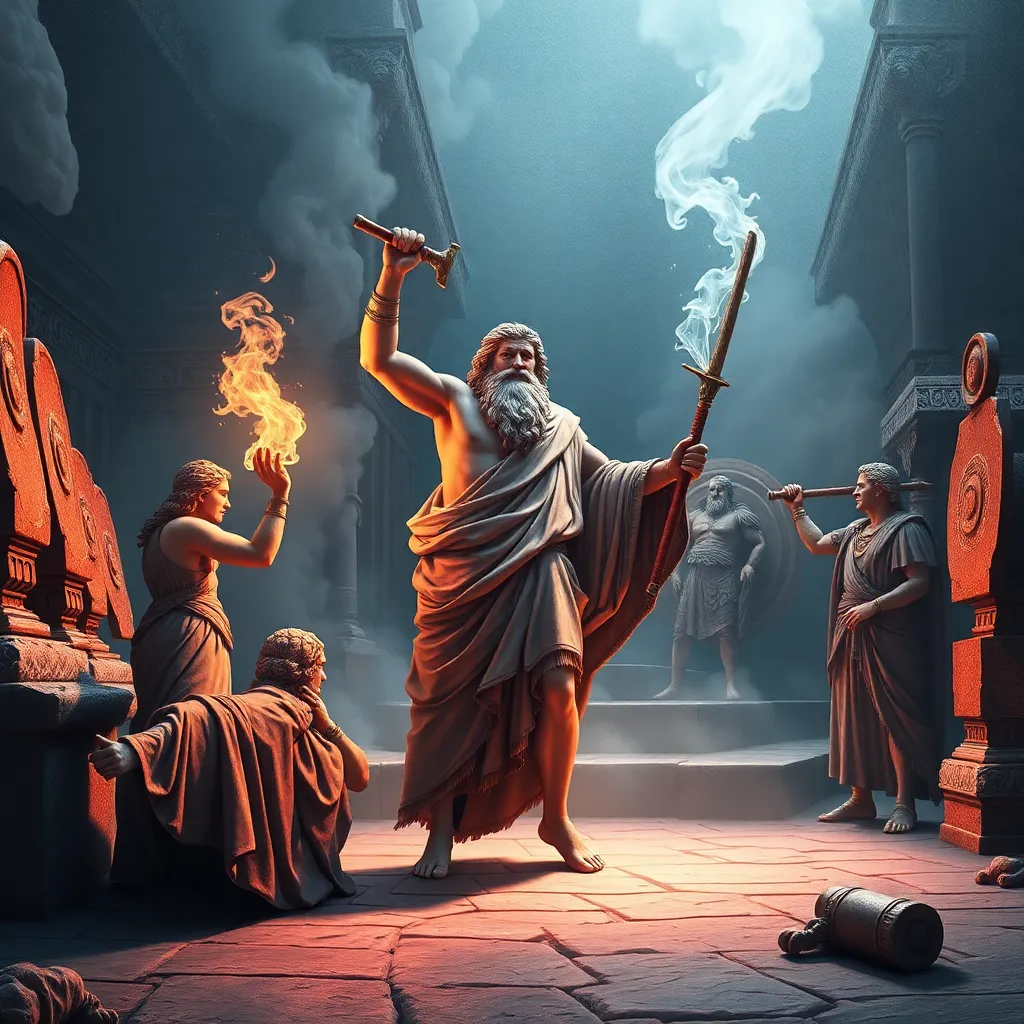The Myths of Hephaestus and His Role in the Divine Hierarchy
I. Introduction
Hephaestus, the ancient Greek god of fire and craftsmanship, holds a unique position in the pantheon of Greek mythology. Unlike many of his fellow deities, who are often depicted as powerful and beautiful, Hephaestus is characterized by his physical imperfections and complex personality. Understanding the myths surrounding Hephaestus is essential to grasping the broader narrative of Greek mythology and the roles these divine figures play in the lives of mortals.
This article aims to explore the life, myths, and significance of Hephaestus, shedding light on his contributions to both the divine hierarchy and human affairs.
II. The Birth and Origins of Hephaestus
Hephaestus’s origins are shrouded in various myths, with different accounts presenting divergent narratives about his birth. In one version, he is the son of Hera, who bore him without Zeus, while in another, he is said to be the offspring of both Hera and Zeus. This duality reflects the complexity of his character and sets the stage for his tumultuous relationships with other gods.
His relationship with his mother, Hera, is particularly significant. In some accounts, Hera, ashamed of Hephaestus’s physical appearance, casts him out of Olympus, leading to his disability. This act of rejection profoundly shapes his identity and his role in the myths that follow.
The implications of Hephaestus’s birth are far-reaching. His status as a “divine outcast” influences the themes of isolation and resilience that permeate his stories.
III. Hephaestus as the God of Fire and Craftsmanship
Hephaestus is primarily associated with fire, metalworking, and craftsmanship, embodying the transformative power of these elements. His domain encompasses a range of skills, including blacksmithing, sculpture, and engineering.
The significance of craftsmanship in ancient Greek society cannot be overstated. Artisans and craftsmen were held in high regard, as their work was essential for the creation of tools, weapons, and beautiful artifacts. Hephaestus symbolizes the fusion of creativity and practicality, serving as a patron for all who engage in manual labor.
When compared to other gods associated with similar domains, such as Prometheus, who is known for his intelligence and foresight, Hephaestus stands out for his practical skills and artistic prowess.
IV. The Myths Surrounding Hephaestus
Several key myths feature Hephaestus prominently. One of the most notable is his marriage to Aphrodite, the goddess of love and beauty. Despite their union, Hephaestus’s relationship with Aphrodite is fraught with challenges, particularly her infidelity with Ares, the god of war. This dynamic showcases themes of love, betrayal, and the complexities of relationships among the gods.
Another significant myth involves the creation of Pandora, the first woman, who was crafted by Hephaestus at Zeus’s behest. Pandora’s box, which contained all the world’s evils, serves as a cautionary tale about curiosity and the unforeseen consequences of human actions.
Throughout these myths, Hephaestus is portrayed as a figure of resilience and creativity, often finding strength in his isolation and struggles.
V. Hephaestus’s Role in the Divine Hierarchy
In the context of the Twelve Olympian gods, Hephaestus occupies a unique position. As the blacksmith of the gods, he provides them with powerful weapons and tools, thus playing a crucial role in the divine order. His creations include iconic items such as Zeus’s thunderbolts and Achilles’s armor.
Hephaestus’s relationships with other deities are complex. While he is often marginalized due to his physical appearance and status as the “ugly” god, he is respected for his skills and contributions. His interactions with gods like Hera, Zeus, and Aphrodite reveal the intricate web of relationships that define the Olympian hierarchy.
His contributions extend beyond divine affairs; Hephaestus also influences human life, as his craftsmanship inspires mortals to create and innovate.
VI. Symbolism and Interpretation of Hephaestus
Hephaestus embodies various symbolic meanings, most notably the duality of creation and destruction. Fire, as a symbol of both warmth and danger, reflects the complexities of his character. His role as a craftsman signifies the importance of skill and creativity, while also hinting at the potential for destruction inherent in his work.
In ancient contexts, Hephaestus was interpreted as a representation of the struggle between beauty and imperfection. Modern interpretations often view him as a symbol of resilience and the value of hard work, emphasizing the importance of perseverance in the face of adversity.
VII. Hephaestus in Art and Literature
Hephaestus’s image has been depicted in various forms of ancient Greek art, from pottery to sculptures. Artists often portrayed him at his forge, surrounded by tools and fire, emphasizing his role as the master craftsman. These representations highlight both his skill and the respect he commanded among the gods.
In literature, Hephaestus appears in works by Homer, Hesiod, and later authors, illustrating his importance in Greek storytelling. His character has also been reimagined in modern adaptations, appearing in contemporary literature, films, and popular culture, where he often embodies themes of struggle and redemption.
The cultural legacy of Hephaestus endures, reminding us of the enduring human qualities of creativity and resilience.
VIII. Conclusion
In summary, Hephaestus stands out as a multifaceted figure in Greek mythology, embodying themes of craftsmanship, isolation, and resilience. His myths reveal the complexities of relationships among the gods and highlight his significant contributions to both divine and mortal realms.
Understanding figures like Hephaestus is essential for appreciating the rich tapestry of Greek mythology. His enduring legacy serves as a testament to the human spirit’s capacity for creativity and perseverance, making him a relevant and inspiring figure in both ancient and contemporary contexts.




